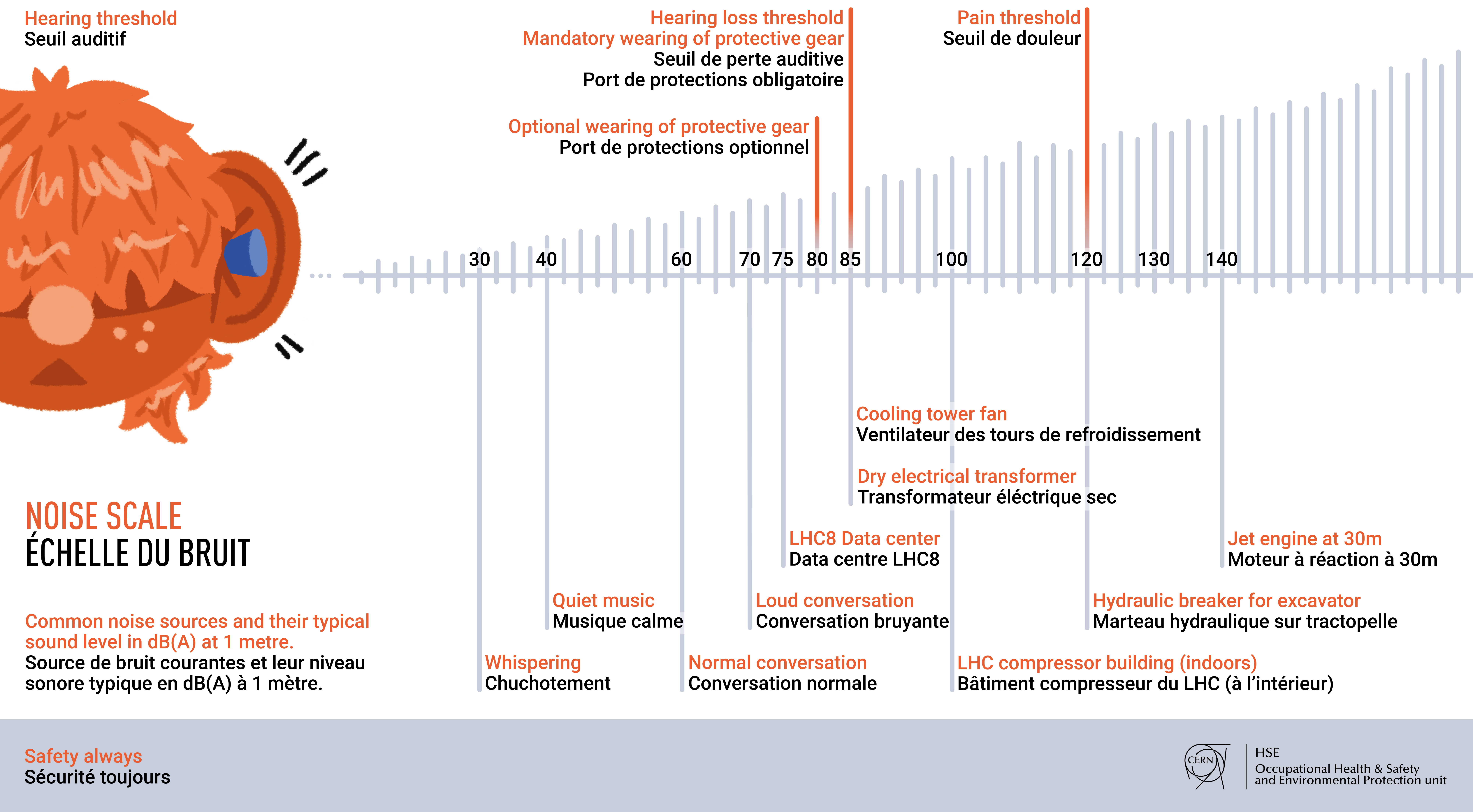Safety risks – Noise
Noise in the workplace is an occupational hazard that besides affecting your hearing, also can cause fatigue, stress, trouble sleeping, cardiovascular disorders and diminish the quality of work. Certain noise levels can affect concentration, hinder verbal exchange, or prevent workers from perceiving warning signs. Finally, it should be noted that sensitivity to noise can vary amongst individuals. An individual worker can feel an auditory discomfort at a noise level that does not disturb the majority of their co-workers.
THE HSE Unit has established a map with hazardous noise levels (>80 dB(A)) in CERN buildings, which is available on the GIS Portal. To access the noise map: Click on the "Data" tab -> "Thematic Map" -> "Safety Management" -> "Noise Risk".
Contents
Regulations
Each worker should together with their supervisor check regularly whether there is a risk of exposure to noise at the workstation. This check should be carried out at least once per year and be recorded in the safety form OHS-0-0-3 for identification of occupational hazards.
General Safety Instruction "Protection of Workers against Noise" (GSI-SH-4)
- This General Safety Instruction defines the obligations regarding the protection of workers against the risk that results or may result from exposure to noise.
Safety Guideline "Noise at the workplace" (SG-SH-4-0-1)
- This Safety Guideline provides guidance as to the implementation of General Safety Instruction GSI-SH-4, in particular with regard to the evaluation of the noise exposure risk of workers and noise control.
Noise scale
Common noise sources and their sound level in dB(A) at 1 metre.

Exposure limits and associated actions
The exposure and action limits and the associated actions defined in CERN’s Safety Guideline on Noise (SG-SH-4-0-1) are primarily designed to prevent the risk of hearing loss. Hearing is considered to be at risk from a level of 80 decibels during an 8-hour working day. If the instantaneous level is extremely high (over 135 decibels), any exposure, even of very short duration, is dangerous.
Click to display a summary of the exposure limits and associated actions.
This table is published in Annex 1 of the General Safety Instruction "Protection of Workers against Noise".
Information for the worker |
|||||||||||||
| Training and introduction to workstation | |||||||||||||
| Occupational health advice in matters of noise protection | |||||||||||||
Protection of hearing |
|||||||||||||
| Personal Protective Equipment (PPE) made available | |||||||||||||
| Mandatory use of Personal Protective Equipment (PPE) | |||||||||||||
Medical monitoring |
|||||||||||||
| Possibility of medical monitoring | Mandatory medical monitoring | ||||||||||||
Other measures |
|||||||||||||
| Signage (Noise hazard) | Signage (Noise hazard + PPE) | ||||||||||||
| Noise reduction programme | |||||||||||||
| Daily exposure | 80 | 81 | 82 | 83 | 84 | 85 | 86 | 87 | 88 | 89 | 90 | 91 | LEX, 8h in dB(A) |
| Peak sound pressure | 135 | 136 | 137 | 138 | 139 | 140 | 141 | 142 | 143 | LpC, peak in dB(C) | |||
Personal Protective Equipment
Protecting your hearing against noise in the workplace is vital. When personal protective equipment (PPE) for hearing is used, it must be selected with a view to eliminate any risk to the worker’s hearing or reducing that risk as much as possible. The different types of PPE for hearing listed in the catalogue of the CERN stores are selected taking into account the advice of the CERN Medical Service and the acoustics specialist in the HSE Unit.
For the PPE to be effective, it needs to be sufficiently attenuating the noise to which the subject is exposed, as comfortable as possible, and permanently worn (before, during, and removed only after leaving the noisy area).

